The information below is merely a process guide. Forex traders have a responsibility to check, adapt this account size determination process and recalculate the minimum account size to their own personal circumstances.
Quick answer
For accounts with 100:1 leverage, 0.1 lot sizing and 30 anticipated open deals
Margin requirements $ 4 117
Drawdown finance required $ 2 000
Safety margin $ 1 200
Account size at 0.1 lots $ 7 300 Mini Account
Account size at 0.01 lots $ 730 Micro Account
For accounts with 500:1 leverage, 0.1 lot sizing and 30 anticipated open deals
Margin requirements +/- $ 827
Drawdown finance required +/- $ 2 000
Safety margin +/- $1 200
Account size at 0.1 lots +/- $ 4 000 Mini Account
Account size at 0.01 lots +/- $ 400 Micro Account
So adjust the recalculate the above if you are enjoying different leverage i.e. 400:1 or 50:1
The above are estimates and the calculation will differ depending on the method margin gets charged by your broker and your specific account used. That is why a safety margin was included: – To cater for variations in margin and drawdowns.
An explanation of how the above was estimated
For any Forex trading system the account size it determined by a number of factors
- The size drawdown expected determines the loss you have to finance
- The leverage you are enjoying determines your margin requirement your need to finance
- Your lot sizing per trade determined the size of the potential loss you have to finance
- The grid size you select
- The value of closed deals at the your maximum drawdown helps to finance any drawdowns
In order to illustrate the above principles we are going to have a look at one of our current test accounts being used to trade the non directional Grid Trend Multiplier. After 40 days the buy and sell accounts show the following results:
Buy account.
Buy account has 12 open deals which require $ 1 647 in margin. The red line on the graph represents the equity level of the account and is a guide toward the drawdown experienced
Sell account
Sell account has 12 open deals (lot size 0.1) which require $331 margin. The red line on the graph represents the equity level of the account and is a guide toward the drawdown experienced
Now the Non directional Grid Trend Multiplier can and should be traded in one account so we are going to add the results above together.
1) Let’s start with the margin requirement.
Both the buy and the sell account have 12 open deals. The buy account required $ 1 647 in margin and the sell account requires $331.47. Why the difference?
The buy account uses 1:100 leverage to finance the 12 open deals. The sell account uses 1:500 leverage to finance open deals.
So if all 24 open deals were financed using 1:100 leverage you would need $ 3294 to finance open deals.
If all 24 open deals were financed using 1:500 leverage you would only need $ 662 to finance open deals.
So to finance 30 open deals would require $ 827 using 500:1 leverage.
To finance 30 open deals would require $ 4117 using 100:1 leverage.
2) Let’s look at finance required for open trades
The Non directional Grid Trend Multiplier needs a Blanket open deals for the multiplier to cash in on every move. In general this blanket should allow for between 20 to 30 open deals at any one time. This blanket covers a range where we hope the price will bounce around in. If the range is too small the multiplier will not work optimally and if it is too big it will be expensive to finance. The table below shows the finance required to finance different sized grid assuming a maximum grid size of 30 open trades. Bear in mind that the bigger the grid size the fewer times the multiplier will work but the bigger your safety range.
As you can see finance required accumulates very quickly
So to finance a gap of 12 pips for 30 open trade levels using the non directional Grid Trend Multiplier will require $ 5,580 using 0.1 lots per trade. Also in the existing example in the sell and buy both have 12 open trades the finance required would be $ 936 x 2 = $ 1872. However if 24 open trades in one direction need to be financed it would take $ 3 600. Seeing that there are currently 24 open deals this level of finance would have been reached at some stage.
So we need to provide enough money in our account to finance 30 open deals which would take $ 5 580.
Next let’s look as gains as result of the multiplier effect.
In the above result we can see that $3 947 was cashed in on the Buy account and $ 3 980 in the sell account. A total of $ 7 927 in 40 days (actually 29 trading days). The range covered was 24 levels. The grid gaps was +/- 12 pips. So, on average the price revisited the same price level 27 times ($ 7 927 divided by 24 levels divided 12 pips per level). This is the power of the Grid Trend Multiplier. It also means that if we need $ 5 580 to finance a blanket of open 30 open trades this blanket has already been financed out of cashed in transactions of $ 7 927.
It means that we have enough in our account to either withdraw quite excessive amounts or finance a much bigger blanket of open trades.
OK let’s look at the drawdown experienced in the above trading account
The Grid trend Multiplier has to build up a blanket of open deals to cover a trading range that allow the multiplier to cash in all trades that occur in the trading range. In the beginning the system generally has a drawdown while that occurs – this drawdown period can last for 1 to 3 weeks. In the above trading account you will notice 2 main drawdowns.
The first drawdown pushed the equity if the buy account down by $2 200. At the same time however the equity of the sell account was +$ 900. So the total drawdown was $ 1 300 at its worst up to then.
The second major drawdown happened in the sell account causing a -$500 drawdown but the buy account was +$3 000 at that stage so no actual negative drawdown was experienced. So the steady growth of the cashed in transactions (blue lines) reduces the impact of drawdowns.
So to calculate the minimum account balance required to trade the above account using a 12 pip gap and a maximum open trade level of 30 is:-
Margin required to finance 30 open trades at 1:500 = $ 827
Maximum drawdown experienced = $ 1 300
Safety finance = $ 500
Total balance need to have traded the above account = $ 2 627
********
The account has equity growth of = $ 6 292
Alternatively: Cashed in due to the multiplier effect = $ 7 927
Less open deals = $ 1 627
The account has equity growth of = $ 6 300
*********
That means that if we had started with $ 3 000 (enough to fund the account) we could have withdrawn $ 6 000 without harming the account. A 200% return of capital in 28 trading days.
This however is with the benefit of hindsight.
An alternative calculation could be:
Margin required = $ 827
Finance required for a 30 open trade blanket = $ 5 580
Worst case finance required = $ 6 407
Account balance introduced – say = $ 4 000
Finance required from the multiplier effect = $ 2 407
The true Grid Trend Multiplier Gamble
Every trading system has its weakness. It is how we manage the trading system in times of weakness that determines the success of the system.
From the above the gamble in the Grid Trend Multiplier is:
- The multiplier should cash in enough trades to allow you to with draw your initial capital and allow you to trade risk free as quickly as possible.
- Or… The price should not exceed the anticipated Grid Trend Multiplier range (Blanket) before you are given a chance to extract your initial capital from your Forex Broker account size
If the price exceeds your anticipated Grid Trend Multiplier range it is better to have a margin call that fight the trend which will eat up more of you money. It your account is profitable when the anticipated range is exceeded consider cashing in the entire blanket of trades profitably and start again.
None of the trades have stops but when more than the anticipated open trades are exceeded a total closure of all open trades should be considered based on the status of your account at that point.
Given the above it is better to use a smaller account to finance 30 open trades exactly as the true stop loss of this system is a margin call. Any account balance bigger and you will be exposing yourself to huge exponential losses. So it is better to experience a margin call and start again than to follow a loss making trend.
My broker gives me a 100% bonus on my account. How does this impact these calculations?
It is best is to ignore the bonus completely. Do the calculations on only you own actual capital in the account using the lots sizing ignoring the bonus. The biggest benefit is that the bonus helps fund your margin requirements turning the leverage from say 500:1 to 1000:1
Questions
If you have any questions please use the Reply facility below

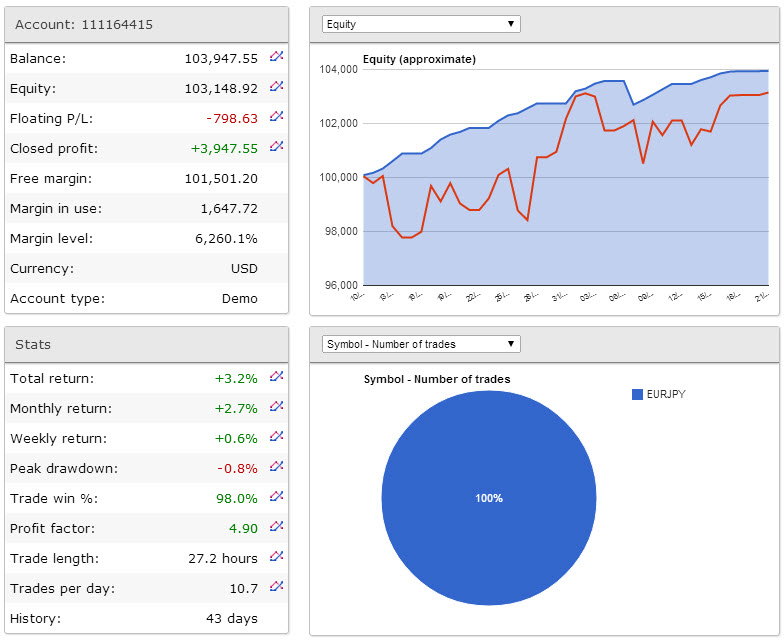
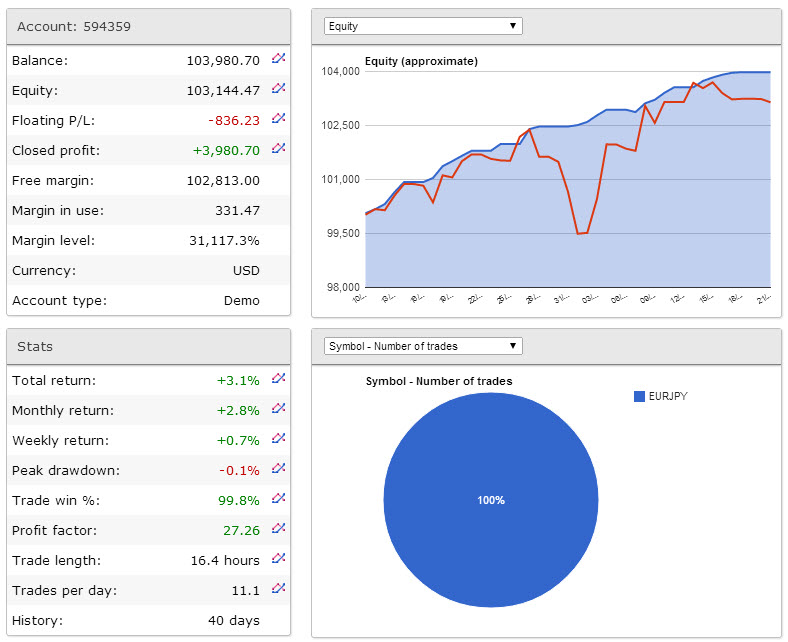
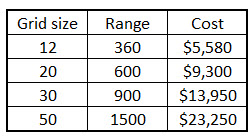
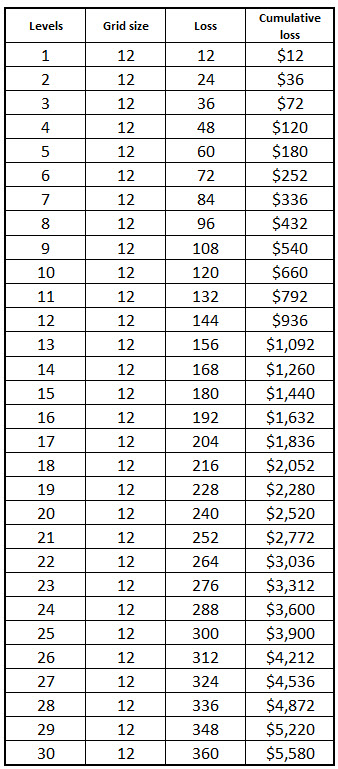
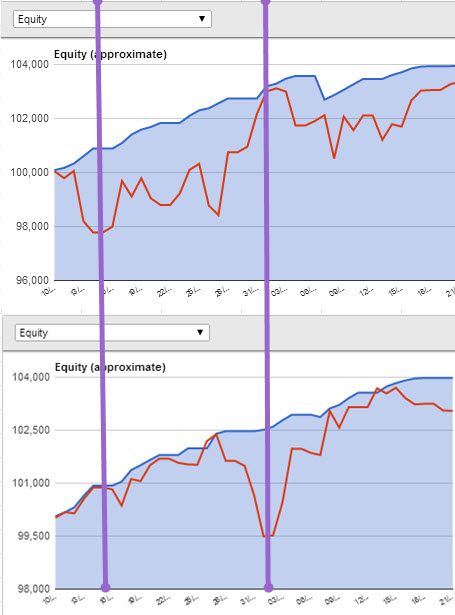
1. Does the GTM enter trades via a pending order or a market order? The reason I ask is that slippage occurs to a much greater degree with market orders. It could be that this is unimportant if the GTM parameters are based upon the entry price rather than a predetermined grid.
2. The above examples are based upon 30 open trades – is this 30 open trades a side (buy/sell = total 60 open trades) or 15 trades (avg.) per side?.
3. In an example elsewhere you suggest having an optimum 12 trades per side open and closing the rest from the largest losers downwards. Is “pruning” throughout the day required or does the software have an automatic trade closure facility?
Can I use this EA with acount of $300. cro acount lot size .01 leverage 1:200?
what ptp size grid?
Thank You
Alex, this explanation is best done with an Excel spreadsheet with step by step calculations…
Yes – It is best done by the traders themselves – happy to check the calculations but they have to be done by the traders themselves – I think there is enough information for traders to do the calculations on excel. It is also a good idea to verify your assumptions using a demo account of the account you are going to use.
IMHO It’s better to be more capitalized, due to the specific features of the system. For me, with a 1:400 leverage and a cent account, an initial amount of 500€ (better than 500$) should be optimal. Does Alex agree?
If you feel more comfortable with a larger account then use a larger balance. In general a large account is not going to save the situation if things go wrong because of the exponential impact of losses. It is however easier to double your account with a smaller balance and you will reach your risk free level faster (after withdrawing your initial capital) when things go well.
I have an account with exness with a 1000:1 leverage which I use for basket trading. I guess this will be ideal for the GTM. What do you think Alex? And by the way, I believe exnes goes as much as 2000:1 although I have never tried that one.
Yes that type of leverage is god for the GTM which does best when it has a big blanket of open deals
I would like to start an account. Tell me the links to do that. I want to link my local bank account so transfer can be accomplished.
Kindly reply to my email as stated above . Thanks
Please use this link top see what is currently available http://archive.aweber.com/expert4x/LKZBL
Please use this link to determine what is currently available http://archive.aweber.com/expert4x/LKZBL
My acct is open at Tallinex and I have deposited $500. Is that enough?
Was the demo account pruned? Why is the average win for the buy at 11 pips while the sell at 9? Seems they had to be at different settings… Is that so?
Dear Alex,
After reading so much , i’m getting a bit confused, so i decided to ask you directly in the simplest form.
I’ll be opting for the Tallinex PAMM investment account
1-would a $1000 deposit be sufficient for this?
2-if above amount is sufficient, then i’ll be able to open the account thru’ link at Tallinex?
3-If I get a reply soon from you, Sir, will I be able to qualify for the May 19th round?
Regards,
Rafiee,
mohd.rafiee@yahoo.com
Thanks for your questions – To qualify to be included in the 19th of May Group you need to open and fund your account by the 18th. As stated the minimum requirement is $400. Try to invest in units of $400 – i.e. $800 or $1200. You account will be automatically linked if you use the link provided on https://gridtrendmultiplier.com/the-grid-trend-multiplier-pamm-service/
Hi Alex,
congrats to your GTM!
In the blue block of the excel sheed there is to enter an amount for the margin. How do I come to this amount?
No sure – try consulting the broker website to find out what your account margin requirements are or even contact your broker. It is something you establish when opening your account.